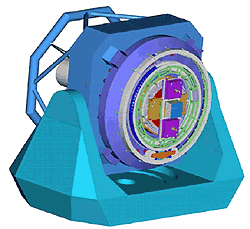Potentially the most exciting discoveries in physical science are expected in the fields of astronomy, astro-particle physics, and particle physics over the next ten years. Gravitational waves from violent astrophysical systems in the Universe are on the point of discovery, particle physics promises to gives us new insights into the fundamentals of matter and what happened in the early Universe, and astronomy could well produce evidence of life in other planetary systems in the Universe. Scottish research groups are playing world-leading roles in these areas and are extending their influence by closer collaboration.
The TEOPS (Technology for Experimental and Observational Physics in Scotland) initiative brings together the Institute for Gravitational Research (IGR), the Experimental Particle Physics (PPE) group (both at the University of Glasgow) and the UK Astronomy Technology Centre (ATC) in Edinburgh. This initiative spans the areas of particle physics, astrophysics and astronomy with a common theme of leading edge technology. More details are available at http://teops.lowtemp.org.
Institute for Gravitational Research
Scotland is unique in having in Glasgow the principal UK experimental team at the forefront of research towards the detection of gravitational radiation. The Institute for Gravitational Research (IGR), under its Director Professor J. Hough FRS, plays a leading part in the UK/German GEO 600 experiment, in the US LIGO project and in the ESA/NASA LISA Project.
Examples of current/recent projects include:
- Development of novel interferometric techniques
- Development of systems of ultra-low mechanical loss for the suspension of mirror test masses
- Development of multiple pendulum systems using silica fibres to support the test masses
- New bonding technology (hydroxide-catalysis bonding), which exibits very low mechanical loss and is compatible with ultra-high vacuum
Experimental Particle Physics: Detector Development
The University of Glasgow has a strong experimental particle physics group (PPE), under the leadership of Prof. D. Saxon FRSE, renowned worldwide not only for its fundamental research in experiments such as Aleph and ATLAS at CERN but also for its applied research in the area of innovative imaging particle and x-ray detectors. The Detector Development group is involved in a wide range of projects related to imaging, radiation detection and detector development, within particle physics, medicine, biology and generic technology development.
Examples of current/recent projects include:
CERN ATLAS - Production and testing of modules for the LHC/ATLAS
CERN LHCb - Design of LHCb/Velo upgrade detectors
CERN Medipix - High sensitivity X-ray imaging for medical and synchrotron applications
CERN RD50 - New technologies for super radiation hard detectors
Retinal imaging - Measuring the electrical activity of retinal tissues
Retinal implants - Pixel detectors as a cure for some forms of blindness
3D - Novel detector geometry for high speed radiation hard detectors
Silicon carbide - Materials for high radiation environment
Gallium nitride - Materials for protein studies
Gallium arsenide - Materials for enhanced X-ray detection
Detector simulation - Simulation using tools such as Medici, ISE, MCNP, Geant4 and SRIM coupled with the ScotGrid computing hardware
Active pixel sensors - New pixel detector technologies
UK Astronomy Technology Centre
The UK Astronomy Technology Centre (UK ATC) at the Royal Observatory Edinburgh is STFC's flagship facility for the design and construction of unique astronomical instrumentation. The mission of the UK ATC is to keep the UK at the forefront of World astronomy by continuing to produce the scientific hardware required to enable cutting edge astronomy to be undertaken.
Dr Andy Longmore leads the Project Science group at UK ATC who work closely with our engineering teams on new instrument concepts. Of our 120 employees, almost 70% are working in technical disciplines including; optical design, electronics, mechanical design, software, cryogenics and vacuum technology.
Some current / recent projects include;
- WFCAM - largest infrared camera ever built, a cryogenic instrument now undertaking unique surveys in the Northern Hemisphere skies
- SCUBA2 - the successor to SCUBA, one of the most successful ground-based instruments ever built, utilising a new generation of sub-millimetre CCD-like detectors
- MIRI - hosting the European PI and opt-mechanical design leads for this key instrument on the JWST, successor to the Hubble Space Telescope
- VISTA an infrared survey telescope destined for the Southern hemisphere and a component of the UKs membership of ESO the European Southern Observatory

Structural CAD design of 3.8m VISTA telescope
The UK ATC is also involved in several UK and European network and technology development initiatives coordinated by our Technology Development Director, Colin Cunningham;
- Smart Optics the UK ATC is a managing partner in this DTI-funded Faraday Partnership
- OPTICON A European network in Optical and Infrared astronomy
- Smart Focal Planes A Framework 6 technology development programme aimed at maximising focal plane 'real estate' in the next generation of Extremely Large Telescopes such as OWL or Euro50
